On a gentle Podhale slope with a sweeping view of the Tatra Mountains panorama, architects from the exexe studio designed five single-family houses for recreational and leisure purposes. Their form is reminiscent of traditional shepherd's huts with steep roofs, while the use of contemporary technologies and materials gave the buildings a modern character.
The complex of houses was designed along an access road. The designers referred to the architecture of the Podhale region, alluding to the clusters of shepherd's huts often found in the Tatra mountain pastures. The houses' steep roofs and eaves protect against strong gusts of wind, while the use of concrete, reflective glass and lightweight structural wood gives the structures a modern look.
The architects made reference to shepherd's huts
vision: Sebastian Grochowski © exexe
In the words of the architects:
The designed ensemble, in keeping with the traditions of the time and place, we adjusted to the topography of the area and oriented the view towards the Tatra Mountains. The repetitive houses were located at varying distances from the road, creating a faulted compositional arrangement, achieving a two-plan dynamic perspective. As a result, the freely spaced buildings will blend into their surroundings, and their layout will be rooted in the landscape context of the Podhale region.
The houses form a faulted compositional arrangement
© exexe
The buildings have been adapted to the relief of the terrain, thanks to a traditional foundation and a diagonal eave line. The use of tan boards on both the facade and roofs alludes to shacks covered with drapery. Traditional gable boarding is replaced by glazing across the buildings, with the exterior creating planes that reflect the picturesque surroundings. In the attics there is a living space with a beautiful view of the Tatra Mountains. Below, the entrance area, bedrooms and garage are organized on the first floor, while the recreation area (mini wellness) is located in the basement.
The form of the buildings follows the geometry of the site
© exexe
Dobrawa Bies: What were the assumptions and design inspirations? Did you manage to achieve all of them?
Ligia Krajewska: The houses were designed as vacation homes. The basic design assumption was to take advantage of the scenic potential of the site, from which, observation of the Tatra Mountains panorama is possible from the access road, running along the longer side of the plot. There was an idea to reverse the typical layout of a single-family building and locate the day-view part in the attic, and the night part on the first floor, at the expense of the possibility of direct exit from the building in the garden part. An important aspect influencing the design was the strong slope of the site. We also wanted to refer to the architecture of the region. As inspiration, we used the architecture of Podhale chalets and tried to give it a contemporary form. Also important was the beauty of the surrounding landscape, which we wanted to make the best possible use of. The form of the buildings follows the geometry of the terrain, the glazing in the living area and the minimalist detailing give them delicacy.
The designers decided to invert the typical layout of a single-family house, placing the living area on the pitta
© exexe
Dobrawa: The houses are reminiscent of Podhale chalets, did you also use a similar traditional construction technique and materials?
Ligia: We referred to the architecture of the Podhale huts non-literally, giving them not only a new function, but also contemporary means of expression. This would not have been possible without the use of currently available materials and technologies - reflective glazing with large dimensions, waterproof concrete or light structural wood. The layout of the buildings, the steep, gabled slopes and the use of homogeneous boarding for the roofs and walls of the buildings are a nod to local architecture.
Traditional gable boarding is replaced by glazing
vision: Sebastian Grochowski © exexe
Dobrawa: What were the investor's requirements and does designing in the mountain region differ from implementation in other parts of Poland?
Ligia: The investor's requirement was to design repetitive buildings for sale or rent, oriented with a view of the Tatra Mountains and adapted to the difficult geometry of the plot. We also used the investor's idea of locating the living area in the attic.
Designing in different regions of Poland each time mobilizes us to explore the building traditions of the region. Creating on or in the buffer zones of landscape parks usually brings with it the necessity of adapting the resulting buildings to the local architecture. This is usually reflected in roof slope angles, as well as the use of local materials, motifs or colors. Mountainous areas are most often characterized by terrain with steep slopes, which forces us to find a way to bring the building into contact with the ground. We try to make sure that our architecture is always adapted to the geometry of the plot and fits naturally into the existing landscape, rather than the other way around, but also that it reflects the times in which we live.
Dobrawa: Thank you for the interview!














































